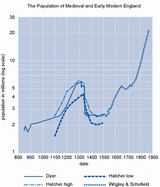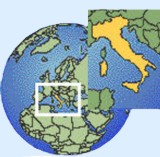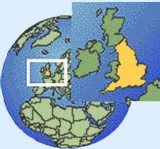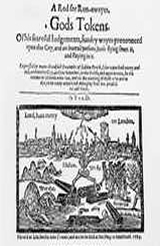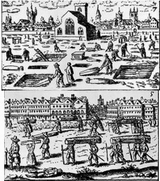Section 3: Historical Epidemics

Bubonic Plague
B:
Contents:
2 of of 9 pictures. Click to see all 9
The plague, properly known as bubonic plague, was one of the most important and certainly the most feared causes of death in medieval and early modern Western Europe.
The massive outbreak in 1348-49, usually called the Black Death, had a devastating short-term impact and possibly an important long-term influence on the population, the economy and even the social structure of Europe.
By the sixteenth and seventeenth centuries, during the reigns of the Tudor and Stuart monarchs (especially Henry VIII, Elizabeth I, James I, Charles 1 and Charles II), bubonic plague had become more sporadic in its epidemic outbreaks, but it was still endemic in the large urban centres, particularly London.
The last substantial outbreak of bubonic plague in the British Isles occurred in 1665, but there were other major epidemics in France (Marseilles, 1720) and Russia (Moscow, 1750s) in the eighteenth century.
In Britain, we could think of the three hundred years between the 1340s and the 1660s as the 'era of plague'. During this period the lives of everyone were in some way affected by the presence of plague or the prospect of its returning.
It is important to distinguish between three forms of plague:
- bubonic plague (which has already been mentioned as the most common form in the past);
- pneumonic plague (which can be passed on between infected humans by water droplets produced by coughing);
- septicaemic plague (which affects human blood, but was probably quite rare).
These three different forms have varying case fatality rates (the last two mentioned are especially deadly; if you contracted these forms of the plague you were very unlikely to survive for long). However, many people did survive bubonic plague during an outbreak, although children and the old, and the poor were most likely to die.
Bubonic plague is really a disease of rodents (especially rats). It is caught by injection into the blood stream of a bacterium called Yersinia pestis (formerly known as Pasturella pestis ).
Like malaria, bubonic plague is a vector borne disease. The process of injection is carried out by fleas which transfer the bacterium between rodents and humans, particularly when the preferred rodent supply declines or is unavailable.
This form of plague gets its name from the buboes (large red swellings) that develop especially in the armpit and groin (see the picture on the left), and the darkening of the skin. The old rhyme expresses the symptoms and consequences rather well. The 'roses' are also red marks on the skin.


Ring a ring of roses
Pocket full of poses
Atishoo, atishoo,
Fall down dead.
For there to be a full-scale epidemic of bubonic plague the rodent population must be infected with the bacillus and the flea population must be capable of passing it on from rat to rat and from rat to human.
The disease can be controlled by limiting contact between humans, fleas and rats or, as is now the case, by treating cases with antibiotics. Only in the case of pneumonic plague can the disease be passed from person to person directly.
In scientific terms none of this was understood until the twentieth century, but it was observed that the isolation of individuals showing symptoms of the disease would help to stop its spread.
It was also noticed that first cases of a new outbreak often occurred in port cities and that ships coming from the Eastern Mediterranean (from the Middle East, Turkey, the Levant and Egypt) were particularly at risk of carrying rats infected with the disease.
It was also observed that plague outbreaks tended to develop during the summer months (when rodents and fleas are most active) and to die away again in winter.
Epidemics of bubonic plague are very dramatic events. They cause massive demographic crises during which the number of deaths far exceeds the number of births in a population.
Fortunately, modern geographers, demographers and human biologists are able to study these crises because in several Western and Southern European countries registers of baptisms, burials and marriages were kept by local parish priests.
England is especially fortunate in having many of these parish registers survive from 1538 (during the reign of Henry VIII), but there are even earlier examples of registers for some of the cities in Northern Italy, Florence and Pisa for example.
Very simple time-series graphs of the number of registered burials in each year or, better still, in each month can be used to indicate which are the 'crisis years' and to suggest whether the cause of the crisis was an epidemic of bubonic plague.
It is also likely that serious plague outbreaks would be mentioned by contemporaries; sometimes they were even recorded in the parish register. But the cities of Northern Italy, the source of the great Renaissance of the fifteenth and sixteenth centuries, went a step further by recording the number of deaths attributed to plague each week.
These cities had especially advanced local administrations for which the development of public health measures became a matter of civic pride. This system for the statistical monitoring of plague was adopted by London and several other European cities.
In London they became known as the Bills of Mortality and, although faulty and inaccurate in many respects, they do at least give us a rough count of the number of plague deaths each month, as well as some other common causes of death. This is very important evidence which is available for long periods during the seventeenth and on into the eighteenth century, beyond the 'era of plague'.
Violent epidemic outbreaks of bubonic plague had important impacts on many aspects of everyday life. They affected trade; they caused the break-up of families; and they created a climate of fear, when would the plague return again? It is important, therefore, to consider several different aspects to the total impact.
Demographic
It is believed that between 33 and 50 per cent of the population of Western Europe died during the Black Death of 1348-49.
However, this is only an educated guess. No one really knows either how many people died because of plague (the numerator) or the total population alive and therefore at risk of dying during the epidemic (the denominator).
The graph on the left shows various estimates by experts like Christopher Dyer, John Hatcher, E. A. Wrigley and Roger Schofield of the population of England from before the Norman Conquest in 1066 to the middle of the nineteenth century. Click on the graph to see a bigger version and explanation.
 Case study: Italy
Case study: Italy 
Because several of the towns in Northern Italy have parish registers which start in the medieval period it is possible to see how plague epidemics created a series of demographic crises during the fourteenth and fifteenth centuries. Click here or on the map on the left to see case studies of Italian cities.
Contemporaries were often surprised how haphazard the spread of plague seemed to be; some towns and villages were missed altogether while others were completely devastated by an outbreak. Since neither the aetiology nor mode of communication were understood at the time it made plague appear a God-directed visitation. Why was our town not spared when our neighbours were?
 Case study: England
Case study: England
Some of the most important research on the impact of bubonic plague has focused on early modern England, especially the period from the 1530s to the 1660s when parish registers are available for many areas.
Click here or on the map on the left to see details of case studies for Devon and London.
Social, Political & Economic Impacts
Many historians believe that fear of plague had an important psychological impact on society and that this can be seen in terms of religious observance as well as in the popular themes of medieval art: death, damnation, hell and purgatory.
They also argue that plague was, at least in part, responsible for the breakdown of the old feudal system. During the century after the Black Death traditional ways of organising labour were abandoned in favour of paying wages in cash for work done. This change was due to the shortage of workers, but also to the growing demands for greater political influence symbolised in England by the Peasants' Revolt of 1381.
However, it is also important to remember that the Black Death occurred in the reign of Edward III, during the Hundred Years War, and between the battles of Crecy (1346) and Poitiers (1356). The plague only led to a temporary suspension of hostilities between the armies of England and France.
Bubonic plague certainly influenced the 'mind set' of Europeans in the late medieval and early modern periods. Many hundreds of thousands died as a direct consequence of the disease, but there were also some indirect yet beneficial consequences in terms of higher wages for peasants and craftsmen, and in the development of special coping strategies, including some of the first public health measures.
Some of the ways in which people coped with such sudden increases in mortality have already been mentioned. They developed early-warning systems and, if they could, they took flight from the affected areas before the epidemic really took hold.
But the massive number of deaths usually led to the suspension of normal life. Dead bodies were simply carted away after they had been checked by the searcher to establish that they were plague victims and placed in mass graves, known as plague pits. Archaeologists sometimes discover these pits during their excavations.
A further response to the plague involved civic authorities developing some of the earliest public health measures. Here are some examples.
- Individuals infected with the plague were often isolated by being sent to special hospitals (where they usually died). In Italy these were called lazarettos and their original use was to isolate people with leprosy (a contagious disease affecting the skin, nerves and mucous membrane leading to skin discolouration, lumps and deformities in severe cases). Alternatively, whole families were locked up in their own dwellings to avoid contact with other people.
- Ships with suspected cases were placed in quarantine for a period of time to see if new cases developed. The crew and cargo were only released when the epidemic was over.
- It was also possible for whole cities and communities to be isolated so that the contacts established by trade, migration and visiting were kept to a minimum.
Sometimes this worked to slow down the spread of the disease, but cheating and evasion of restrictions would also have been common. The famous case of the village of Eyam in Derbyshire has become a legend. There in 1665 members of the village community are supposed to have volunteered to isolate themselves (effectively to put themselves in quarantine) so that the spread of a plague outbreak could be contained. But there is much folklore surrounding this story; the extent of quarantine and the number of villagers involved may have been exaggerated.
- Local magistrates also took measures to control the opportunities for people to congregate during a plague outbreak. One famous consequence of this practice was the closure of the theatres in Tudor and Stuart London so that the companies of actors and playwrights, William Shakespeare included, were temporarily put out of work. During these periods in the 1590s and early 1600s Shakespeare turned to writing poetry for publication rather than plays for performance.
It is difficult to judge how effective these public health measures were in the absence of the ability to properly diagnose and treat bubonic plague, but they probably helped to limit the spread of epidemic outbreaks into Western Europe and from the larger towns into the countryside.
However, leaving a locality in which cases of plague were starting to appear was certainly the most effective strategy for an individual during the sixteenth and seventeenth centuries.
Click here to link to Radio 4 site with a case study of Bubonic plague in Salisbury.
Disappearance from Western Europe
The disappearance of bubonic plague from Western Europe has still not been fully explained.
Some medical historians think that the bacterium became less virulent; others that the disease vector's host became increasingly separated from human beings as brick houses replaced timber-framed dwellings; others emphasise the importance of quarantine measures in restricting plague to those areas in the Middle East where it remained endemic.
It is quite possible that all of these developments occurred together and supported each other in reducing exposure to infected fleas.
Today there are still many countries in the world where cases of bubonic plague do occur (see the map on the left).
The United States Centers for Disease Control (CDC) monitor these outbreaks, which are rarely of epidemic proportions, and make efforts to control the disease in rodent populations where it is still active.

3. Why is bubonic plague often called the Black Death?
7. What are the records of deaths in London known as?
9. Bubonic plague has a seasonal pattern. In what season are most cases?









